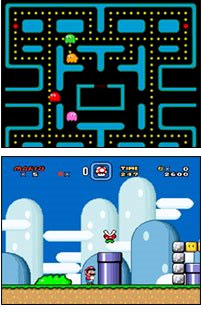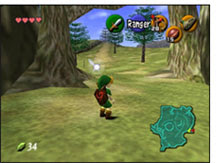The short answer is no. Take a look at the 3d FOV once again, which in our analogy, is similar to a 3d cube. Imagine, now, that there is a 2d picture in the center of the FOV. In our world, assuming we do the same with a transparent cube, we would be able to see that 2d picture from almost any angle, because that shape would occupy a large portion of our own 2d FOV. But if we look at that picture from the "side", it will look like a small line to us, and occupy a small portion of our FOV. Therefore, it would be almost unperceptible. A real 1-dimensional line would be impossible for us to perceive, but we can perceive a real 2-dimensional shape as long as we look at it from a certain angle.
Analogously, a real 2d shape would be impossible for a 4d entity to perceive. Once you place a factual 2d shape inside the 3d FOV, it will look infinitely small. Unlike our transparent cube in the previous example, there is no empty space on the 3d FOV: it is a solid cube, filled with the nearest 3d information. The 2d shape would be hidden in the center of the cube, next to more perceptible 3d volumes. Since 4d entities can only focus on particular 3d volumes of the FOV, this 2d shape would only take a infinitely small portion of the information currently on focus. Therefore, 4d entities can't perceive 2d or flat 3d shapes.
This lead us to assume that, even the simplest of the games in the 4d world would make use of 3d geometry. In the following sections, we are going to retrace the evolution of video-games in our own world, and by analogy, imagine how would video-games evolve in a ficional 4d world, from the simplest forms to the most advanced.
Basic 3d Games
 |
What that means is that the second game, while still being 2d, attempts to simulate our reality by using background images and layers. The first game, however, creates a reality of its own, without trying to portrait ours. That's important in our analysis because the 2d world mentioned in previous articles can be compared to the first game. Any 2d game with more than one layer of image doesn't depict a 2d world accurately.
With that in mind, we can assume that in a 4d world, there are also two kinds of 3d games: pure and layered. Pure 3d games can be used to portrait the reality of a 3-dimensional world. That means a 3d screenshot of such game would, in a way, appear to be a 3d model that we can easily understand, as long as you exclude the "black space" from this model. The black space I'm refering to is similar to the black background on the first game above: it is just there to fill in the gaps, but in a 2d world, that would be only space.
Let's try to imagine a simple tetris game in the 4d world: the equivalent of a simple, unlayered 2d tetris in our world. The rules are the same: blocks come falling from above and the player must control their position and orientation before they hit the bottom. Since 4d entities have a 3d FOV, the space through which these blocks fall is a cubic shape, and not a rectangle, and the pieces are also 3d shapes. The game would be presented in a way that it would only take a small portion of the 3d FOV. In our version of the game, once a row is entirely filled up, the parts of the pieces that are in that row (which are small 2d squares) disappear. Similarly, in the 4d version, once a grid of the bounding cube is entirelly filled (ie, an entire grid is filled with small 3d cubes) those cubes disappear. Notice that if we tried to play such game, we wouldn't be able to see 3d blocks that are "under" other blocks, unless, of course, these blocks were transparent (although that would still be confusing). But 4d entities can see all points of the 3d FOV, just as we can see all points of our 2d tetris game. Notice, also, that most of the space of the 3d FOV would not be blank space, but would be filled with "black background" (or black pixels; remember that the display screen of their TV set is a cube, and not just a surface like in our world). Note: I'll refer to the entire image formed by the pixels generated in the 3d screen as an hologram.
We can also try to imagine very basic 3d layered games. A game similar to our tetris game with a background image would be similar to the one described above, but instead of the black pixels, there would be a different 3d hologram that would be the equivalent to our 2d photos. So let's imagine a simple tetris game in the 4d world with a tesseract as the background image, and let's exclude the black background information that would make up the rest of the background. In the beggining of the game, the bounding cube would still be appearing in the center of the 3d FOV, but now, in its center, you would be able to see another 3d cube, which is the 3d projection of the tesseract (as seen in previous articles). Even though it is a 3d shape, the 3d blocks can fall "through" it, and occupy the same space as the tesseract projection. It's important to understand this concept, because that's how 4d entities actually perceive their world: they see a cubic 3d shape that keeps changing constantly, with closer 3d projections occupying the space of projections of 4d objects that are further away. In this case, however, the tesseract is not further away from the observer: the tesseract, the bounding cube and the 3d blocks are all part of the same hologram that changes with time.
 |
They wouldn't. This is where their version of the game would differ from ours. Imagine, for a second, an unlayered 2d game in our world that tries to simulate the reality of a 2d world. In reality, we are simulating that reality from our point of view. That means, in a true unlayered 2d game, we can only see a small portion of that 2d world at a time, and we can not see the sky or anything that is too far from the main character. Notice that a 2d entity has a 1d FOV (a line), and this entity could look up to see the sky, which would then fill up its FOV. But we are not playing the game from the point of view of 2d entities.
So, in the 4d version of Zelda: OOT (or rather the unlayered 3d version in the 4d world), the 4d entities would only see a small portion of the 3d scenery at a time, and the camera angle would most likely to be fixed and locked on Link, since for them, there is no difference between seeing a 3d scene from an angle or another. The space that is not filled with the ground, the characters, enemies or other objects would be filled up with empty (black) pixels, and not with the sky, or any other information. That seems very restrictive for the 4d entities, and it is, which is why they would eventually evolve their games into layered 3d games.
Layered 3d Games and True 4d Games
Let's imagine, once again, a layered 2d game that tries to simulate our 3d world. Notice that, even if you ignore the background and foreground layers, it would be impossible for the 2d characters of these games to live in a true 2d world. For example, a 2d character might be holding a weapon on its right hand. In a 2d world, that would be like holding a weapon "inside" itself. That means the information on layered 2d games just can't be used to imagine a 2d world, they are more like 2d projections of a 3d world.
By analogy, we can say that layered 3d games are made up from 3d projections of the 4d world. There is no 3d game in our world that can be compared to a layered 3d game. However, we can still speculate about it to some extent. Looking again at our 2d layered game, we can say that a 2d entity would perceive it as something similar to their own world, but with solid information filling up what would otherwise be empty space (ie, the background and foreground images). This information would change constantly. Also, the characters portraited in this game would be perceived as 2d entities that have a morphing ability. Remember that, for 2d entities, only the contour of 2d shapes is perceived.
Finally, the mechanism of the game would be similar to that of unlayered games. That means the mechanism of a 3d layered game in the 4d world would be similar to the example given above (of the Zelda game). In essency, the 3d FOV would still display a small 3d scenery with a fixed camera angle (locked on the main character). But now, the empty 3d space would be filled with different colors and shapes, and not just black pixels. The model of Link would also be different. It would have the same overall shape (assuming we are only porting the same game to a layered style), but the insides of the 3d model would also be textured accordingly to simulate a 4d entity. The shape of the character would also change constantly, just like the tesseract appears to change shape when it rotates.
As you can see, a layered 3d game would make full use of the 3d FOV of 4d entities, but the game would still be very restrictive for them. This lead us to the final stage of evolution of games in the 4d world: true 4d games. This type of game would simulate a 4d world, which means the hologram that fills up the 3d FOV would be constantly changing, and the FOV would not act like an ordinary 3d camera anymore. At least not always - a true 4d game, if viewed from a specific and fixed angle, might look very similar to our own world. This simple comparision might help us understand the point of view of a 4d entity.
1 comments:
Incredible, i would love to investigate more deeply about this.
Post a Comment